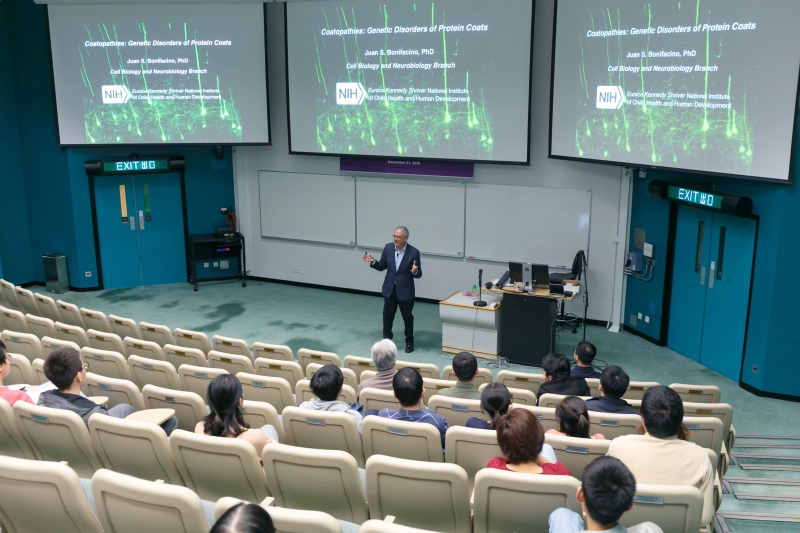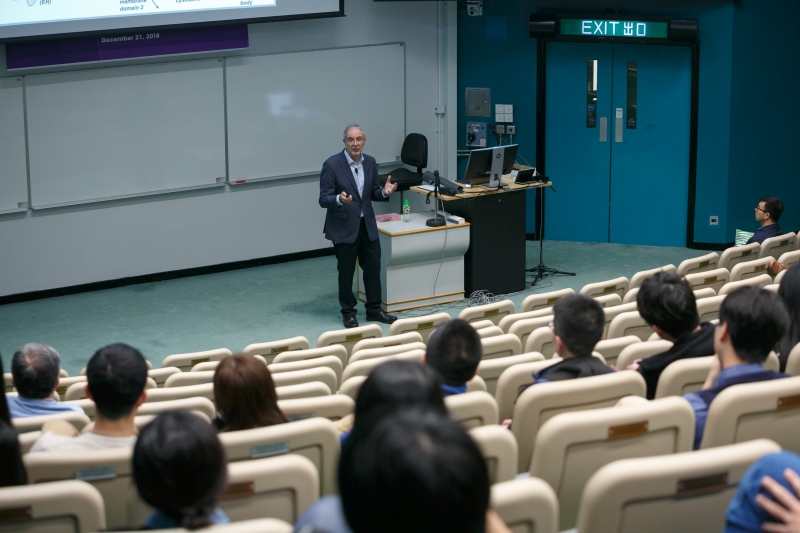Coatopathies: Genetic Disorders of Protein Coats
Abstract
Transport of cargo between different compartments of the endomembrane system of eukaryotic cells depends on protein coats that mediate cargo sorting and transport vesicle formation at the donor compartment. Mutations in components of these protein coats are the cause of various genetic disorders that the speaker and his collaborators refer to as “coatopathies”. They have recently studied the mechanism by which mutations in the AP-4 coat cause a complicated form of hereditary spastic paraplegia (HSP) termed “AP-4-deficiency syndrome”. The HSPs are a clinically and genetically heterogeneous group of disorders characterized by progressive lower limb spasticity (i.e., leg stiffness). In addition to lower limb spasticity, AP-4-deficiency syndrome features intellectual disability, microcephaly, seizures, thin corpus callosum and upper limb spasticity (i.e., tetraplegia). To investigate the pathogenesis of AP-4 deficiency syndrome, they characterized a knockout (KO) mouse for the AP4E1 gene encoding the epsilon subunit of AP-4. They found that AP-4-epsilon-KO mice exhibit a range of neurological phenotypes, including hindlimb clasping, decreased motor coordination and weak grip strength. In addition, AP-4 ε KO mice display a thin corpus callosum and axonal swellings in various areas of the brain and spinal cord. Immunohistochemical analysis showed that the transmembrane autophagy protein ATG9A is more concentrated in the trans-Golgi network (TGN) and depleted from the peripheral cytoplasm both in skin fibroblasts from patients with mutations in the μ4 subunit of AP-4 and in various neuronal types in AP-4 epsilon KO mice. ATG9A mislocalization was associated with an increased tendency to accumulate protein aggregates in the axon of AP-4 epsilon KO neurons. These findings indicate that the AP-4 epsilon KO mouse is a suitable animal model for AP-4 deficiency syndrome, and that defective export of ATG9A from the TGN and impaired autophagic degradation of protein aggregates might contribute to neuroaxonal dystrophy in this disorder.
About the speaker
Dr. Juan S. Bonifacino received his doctoral degree in Biochemistry from the University of Buenos Aires in Argentina in 1981. He then moved to the US National Institutes of Health (NIH), where he pursued postdoctoral studies. He rose through the ranks and is currently the Head of the Cell Biology and Metabolism Program (CBMP) of the Eunice Kennedy Shriver National Institute of Child Health and Human Development (NICHD) at the NIH, a position that he has held since December 1997. In 2008, he was appointed NIH Distinguished Investigator.
Dr. Bonifacino and his group at the NIH has been conducting research on signals and adaptor proteins that mediate sorting of proteins to endosomes, lysosomes, lysosome-related organelles such as melanosomes, and different domains of the plasma membrane in polarized cells such as neurons since 1990s. His group discovered new sorting signals and adaptor proteins, and applied this knowledge to the elucidation of the causes of various human diseases including the Hermansky-Pudlak syndrome type 2 (HPS-2) and HIV-1 pathogenesis. In addition, his group identified novel components of the molecular machinery involved in retrograde transport from endosomes to the trans-Golgi network (TGN), and in recycling from endosomes to the plasma membrane. In addition to continuing these studies, he is currently investigating the molecular mechanisms that control the movement of endosomes and lysosomes in non-neuronal and neuronal cells, and the connection of these mechanisms to neurodevelopmental and neurodegenerative disorders.
Dr. Bonifacino served in various editorial capacities at the journals including Developmental Cell, Molecular Cell, Journal of Cell Biology, Molecular Biology of the Cell, Journal of Biological Chemistry and Traffic. He is also the co-editor of the books, "Current Protocols in Cell Biology" and "Short Protocols in Cell Biology". He was a member of the Council of the American Society for Cell Biology and chaired various scientific conferences. He is also an Honorary Professor of Biological Chemistry at the University of Buenos Aires and a Sackler Lecturer at Tel Aviv University in Israel.











